December 27, 2004
rand()%commissions

Generating Randomness
rand()%, in partnership with The Media Centre, Huddersfield (UK), is pleased to announce the first in a series of commissioned generative audio works. The idea was to commission new works specific to rand()% which explore randomness and generative music composition.
The first commission is from Alku and comes in the form of several works tying together their Formatissimo series and culminating in their installation e+ included in our rand()%lab exhibition. ALKU: Formatissimo I+II, e+ http://www.r4nd.org/c_alku.html
The second commissioned piece is by Dextro. This includes several modified pieces from the recently released Dextro: A / Turux - b CDRom and a new automatic work entitled m000.dxr.DEXTRO: m108_rand_A, m108_rand_B, m108_rand_D, m000.dxr http://www.r4nd.org/c_dextro.html.
To hear these works please check the daily schedule.
Posted by jo at 05:01 PM | Comments (0) | TrackBack
netzwissenschaft
![]()
Emerging Infrastructures of All (Inter)net Research
Dr. Reinhold Grether's network research | netzwissenschaft site maps the "emerging infrastructures of all (inter)net research endeavours. net.science as an anthropology of connectivity is trying to overcome the constraints of specialist method transfers on net matters. the protuberance of technical networks necessitates a professionalization of human net knowledge. neither the isolation of concepts as in basic research nor the encapsulation of processes as in applied sciences will ever be able to adequately describe the complex autopoiesis of networks. net.science is undoubtedly developing into a scienza nuova of its own right."
Check out his Mobile Art and Virtual Performance research areas.
Posted by jo at 04:45 PM | Comments (0) | TrackBack
December 09, 2004
msdm
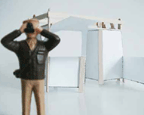
researching mobile strategies of display & mediation
msdm [mobile strategies of display & mediation] is an imaginary organisation founded in 1998 by paula roush to research mobile strategies of display & mediation. A hybrid of artistic, curatorial, experimental practice operating in the interstices of institutions and social systems, the organisation aims to propose participatory alliances for transversal, critical, cultural and aesthetic outputs. The collaborations have extended into the domains of open source software, publishing, para-architecture, public signage, radio streaming and mobile media platforms. They have been shown in galleries, museums, non governmental organisations and independent spaces, including Space Studios, Coleman Project Space, The South London Gallery, the Institute of International Visual Arts, the Bauhaus Foundation, Gesellschaft fur Aktuelle Kunst and the Living Art Museum.
Projects include:

geneticSilence: Public intervention and installation at the Living Art Museum in Reykjavik for the project Polyphony. A bus tour -the ’genetic noise tour’- was organised connecting the gallery with the street. The initial proposal was to have it to collect tourists in the city centre and take them on a tour of the high security genetic labs in the surroundings of Reykjavik. Because the right bus could not be found, the project took another shape and the tour was done in a small VW van, with the tech crew streaming the sound and images to the museum. The accompanying wall catalogue and public newspaper boards showed an archive of the links between art, genetics and architecture. The word ‘art’ -privatised by a genetics research company- was ‘corrected’ in the museum signage with the corresponding patent number.

bowville: bow wireless/ space studios/ london; locative media performance, 2004. Marion Manesta Forrester was electronically tagged. She had 3 days to earn her right to become a citizen of Bowville. People had to vote for her to stay or to go by phone, online or in person by visiting the Bowville Investigation Bureau. Download Bowville Booklet, 9 pages (pdf, 656k) or individual pages at higher resolution : page 1 | page 2 | page 3 | page 4 | page 5 | page 6 | page 7 | page 8 | page 9 |

SOS:OK: A work generated in response to Biscuit Town, the name given to the area surrounding Peek Freans biscuit factory. Biscuit Town was a marker in both organisational and representational forms of labour. It was the first mass producer of biscuits and commissioned the first documentary film shot on location (A Visit to Peek Freans, 1906, BFI Archive). At its core there is an artistic intervention that crosses a gallery installation with a public art intervention. The aim is to produce an emergency biscuit in response to the history of the site (Peek Freans was the first factory to manufacture an emergency biscuit ration to feed the starving population of Paris during the Franco-German war 1870-71) and the current international state of emergency. The launch and the time based performance at Coleman Project Space is inserted into a wider public campaign which includes billboards.
Posted by jo at 05:44 PM | Comments (0) | TrackBack
December 08, 2004
Simultaneous Translation - A Networked Collaboration
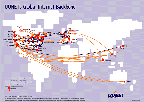
Distance and Time Through the Lens of Streaming Media
Friday December 17 & Sunday January 16, 2004; Madrid, Spain 20:00 (19:00 Greenwich Mean Time. 2PM Eastern Standard Time); Concert and live internet audio stream. Developed by John Roach with Miguel Ramos and Willy Whip Performers: Carlo Giordani, John Hudak, The Same Room Left, James Rouvelle, Mike Rosenthal, John Roach & Miguel Ramos.
Simultaneous Translation is an international networked performance that draws connections between language and the internet. Just as language has changed over time and as dialects have evolved as groups of people moved geographically from place to place, so in this project, live sound will be effected by time and distance. Audio created by the participants in Madrid, the US, Germany and Italy, will be broadcast live on the internet. [Related]
Posted by jo at 11:54 AM | Comments (0) | TrackBack
December 03, 2004
Grand Thieves Audio modologues
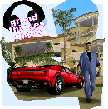
We're tired of stealing cars. So we're stealin' the soundtrack...
Grand Theft Auto: Vice City, an earth-shaking game of theft, prostitution, , and beautifully animated racist depictions of Cubans and Haitians. You are free-wheeling Tommy Vercetti, driving any car you can pop the lock on, taking s out to the lighthouse, enjoying all the pixilated pleasures the 80s can offer you. Bunk is making the game that much better because we're putting somebody in the car with you. We're carjacking the game with a mod of our own...This is only the beginning, the first in a series of monologues (or modologues) and performances we're testing out. Send us yours and we'll feature them on the page...(Modologue: Machinima-style dubbing that modifies game-play through an alternate narrative.)
"On Bunk, we've published the beta of the "Grand Thieves Audio" project. These MP3s constitute our attempt to carjack the audio on "GTA: Vice City." These audio files attempt to recontextualize the playing experience along subversive avenues. The idea is to create the illusion of new (subversive) nonplayer characters in the game through the audio."
These modologues combine the audio dubbing of machinima with the infiltration of game mods (since sticking them in your MP3 folder does not alter the code of the game). Unlike Machinima, which dub sound tracks over edited clips of game play and turn the player into a spectator, these monologues, or "modologues," let the user play in a different narrative context.
These files represent the first attempts to infiltrate the game. I hope other performers will record some and send them our way so we can build a library.
Current downloads include: Army Recruiter (since video games are now tools of recruitment), Mama Vercetti, The Driver's Ed Instructor, and Arnold Schwarzenegger (though this last is anachronistic and probably more suitable to "San Andreas")."
Posted by jo at 10:38 AM | Comments (0) | TrackBack
December 02, 2004
Energie_Passagen
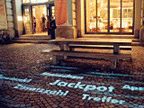
Public Voices Thrown Into the Flow
From Audiohyperspace: "Emergie_Passagen: Reading and (De)Scribing the City" - so the subtitle of this interactive audiovisual installation, which [could] be experienced until November 29th on Munich's Salvator Place. The installation understands a city's public speech - its inhabitants' chatting, the language of politics and media - as diverse streams of energy, from which an architecture is taking shape. The latter is made audible and visible by the art work. Every evening between 6 and 10 p.m. the square in Munich's city center is becoming a place, where a mediated, up-to-date intellectual-political milieu is emerging. The installation is mainly dealing with the interactive generation of semantic connections. A process, which can be initiated by every single passer-by and whose principles can be followed very well online.
Starting point for "Energie_Passagen" are texts taken from a mass medium, the daily newspaper. An automated computer process analyses the German newspaper "Süddeutsche Zeitung" and reduces it to catchwords. The terms which are filtered in this process are then projected as the "information flow" on the square "Salvatorplatz" in Munich.
As a visitor, you can choose between terms and "throw" your choice into the flow. Thus, movements of text are initiated and links between the terms become apparent. The resulting networks of terms create contextual links and new meanings which differ from the original linear texts. Computer voices immediately react to your "input" and accompany you in an echo of many voices.
In addition, a world map visualizes the path through the geographic landscape of news which the visitor takes based upon her/his choice. A developing linear illustration emphasizes the links between local location and global events.
The visible result of this interactive process is the "Living Newspaper". Its dynamically generated texts are projected on the square's "information cube". Newspaper texts are fragmented and transformed, creating new sense or non-sense. - A model maybe, how texts become catchwords, catchwords become arbitrary language patterns. It shows, how not content is the object of mental appropriation, but selections of terms and words are based on association and deliberate playfulness. By this, an intellectual is emerging, coined by the concert of terms and catchwords.
A livestream, accessible via the project's index page, makes the process audible via Internet.
Posted by jo at 10:21 AM | Comments (1) | TrackBack
November 07, 2004
DEAF04

participatory locative sound imaging hoedown
Dutch Electronic Art Festival (DEAF) is a biennial international festival for electronic art, presented by V2_, Institute for the Unstable Media, in Rotterdam, The Netherlands.
TRAMJAM V.03- ROTTERDAM RUSHHOUR by Mumbai Streaming Attack is a multi-track- multi-driver mix hub streaming jam session of Rotterdam city vibe, orchestrated in sync with the city's tramlines' routing schedule. Play along November 12 if you're in Rotterdam. Mumbai Streaming Attack is a networked performance study group currently based at SNM/HGKZ in Zurich.
Also at DEAF04 (and simultaneously in New York, Brisbane, Linz, and Singapore) is media artist Zhang Ga's public art project The Peoples' Portrait, where five photo-capturing kiosks, including the location in the Times Square Alliance Information Center at 150 7th Avenue in New York City, are set up globally to capture a diverse range of people in their unique environments. Every few seconds, a central server will retrieve the portraits and display them first in time stamped order, then randomly from the archive. [Related]
Originally posted by Eli Chapman on unmediated
Posted by jo at 06:55 PM | Comments (0) | TrackBack
October 30, 2004
Radioscape III
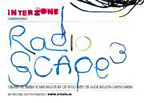
Mixing the City
In Radioscape III--a project by Edwin van der Heide--there are fifteen transmitters installed around and on the Leidseplein in Amsterdam, each broadcasting its own musical layer. Van der Heide designed a receiver that allows you to receive and mix the signals of two, three or more transmitters simultaneously. At a certain moment you receive one transmitter the strongest, the second a bit softer and the rest might be inaudible. By walking through the environment the balance between the transmitters is changing, new ones are fading in while others are fading out. Van der Heide: "The city centre forms a musical labyrinth with different layers of sound that, together, form a meta composition. By moving you mix the different layers which lead to new combinations and interferences."
Radioscape is open from Thursday the 28th of October till (including) Sunday the 7th of november. You can obtain a Radioscape receiver at the counter of De Balie. They can be fetched between 13:00 and 20:00
Radioscape is freely accessible for the audience. In order to borrow the receiver you have to deposit either 50 euro's or an id card. You have up to one hour to 'radioscape'.
Radioscape III is part of the Interzone series by De Balie, a series of artistic explorations crossing the borders between the existing artistic disciplines.
Posted by jo at 10:14 AM | Comments (0) | TrackBack
October 28, 2004
The Click Sneaks
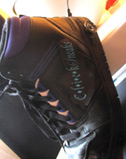
Tap for the Streets
New York designer and researcher Despina Papadopoulos, the founder of Studio 5050, had the idea for the Click Sneaks while walking down a cobblestone street, wearing sneakers next to a friend wearing stilettoes.
The artist recorded the "click" sound of high heels on a voice chip and had it activated on each step the revamped sneakers take. A speaker, an amplifier and a sensor acting as a "switch" on the sole of each foot, transform these seemingly normal sneakers into a sound performance.
Via Horizon Zero. originally from Popgadget: Personal Tech for Women, reBlogged by bev on btang reblog
Posted by jo at 09:07 AM | Comments (0) | TrackBack
October 27, 2004
The Wild is Calling

Call of the Wild
A project by Amos Latteier, Call of the Wild " is a series of audio tours of downtown Portland that are accessed by cell phone. The tours focus on plants and animals in downtown, contrasting them to their human cohabitants. Using natural history, philosophy, and humor the tours reveal urban biological systems that we see everyday but seldom notice.
Urban ecosystems demonstrate how technology and the urban environment mediate nature. Starlings, pigeons, and moss show us how to adapt, survive, and flourish in changing and artificial surroundings. Call of the Wild examines urban wildlife with an eye to the lessons it can teach us about our own technologically mediated lives.
Cell phones provide a unique, practical, and fun venue for conducting audio tours. Cell phones are already an integral part of the urban environment, and using them for audio tours transforms a device that normally removes people from the environment into one that help focus attention on it."
A wonderful concept, and an effective example of the possibilities for creative content delivered to the public via cellphones.
Posted by MK at 01:26 AM | Comments (1) | TrackBack
October 18, 2004
AudioHyperspace

audio »visions«
The Internet offers to the media as well as to the media artist a new electroacoustic space, abundant with audible live streams, audio on-demand, sound files and increasingly complex interactive audio art. These new possibilities may open up surprisingly new audio »visions« and provoke new strategies of perception. Audio on the Internet has made the boundaries between art, communication and play flexible. This offers a perspective on radio concepts and on radio art designs. AudioHyperspace guides you through the jungle of sound data and explores the development of sonic web art: every month it selects the most interesting audio websites and presents an annotated collection of links to audio and audio art on the web. Some examples of interviews:
Mobile Listening - Electrical Walks
Christina Kubisch in Conversation with Sabine Breitsameter
Sonic Art in Hertzian Space
Teri Rueb in Conversation with Sabine Breitsameter
Birdsong for the Mobile Age
Sadie Plant in Conversation with Sabine Breitsameter
Posted by jo at 12:56 PM | Comments (0) | TrackBack
October 11, 2004
Auracle
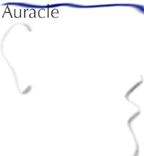
A Networked Instrument
Auracle, a voice-controlled, networked instrument on the Internet, was created over the past year at Akademie Schloss Solitude in Germany by the Auracle team (Max Neuhaus, Phil Burk, Sekhar Ramakrishnan, Kristjan Varnik, David Birchfield, and Jason Freeman--read PDF). The project is inspired by Max Neuhaus' interactive radio works from the 1960s and 1970s.
The site is now live, and you can try out Auracle at any time (you'll need a computer with a microphone). The official launch event is Friday, October 15th at Donnaueschinger Musiktage, a new music festival in Southern Germany. You are welcome to join in via the Internet by using Auracle at 2:30 p.m. Eastern Standard Time this Friday; see the web site for details.
Auracle is a networked sound instrument, controlled by the voice. It is played and heard over the Internet. To participate, simply launch Auracle in your web browser, join an ensemble, and create sounds with other participants in real time. While it takes years to learn how to control an instrument such as guitar or piano, Auracle requires no special training to play. It takes advantage of the sophisticated and flexible vocal control we all have from our ability to speak.
Your voice, however, is not the source of Auracle's sounds — it is merely a way of controlling those sounds. You play Auracle with other people anywhere in the world in groups of up to five players called Ensembles. All members of an ensemble are able to hear each other's gestures. Listen to the active ensembles in Auracle by clicking on their names. Stay with a group that you like, or create a new ensemble yourself and invite others to come and play.
Auracle is an instrument, not a piece; it is a system, not a musical composition. It has an internal structure, but it does not define or control the interaction of its participants. The architecture itself adapts over time in response to how it is used.
Posted by jo at 02:58 PM | Comments (0) | TrackBack
September 28, 2004
DENSITY Bus Tour

Sound in Motion
DENCITY is a live performance of electro-acoustic music on a nightly bus tour through New York's hidden landscapes. It is the contemporary urban equivalent of an explorer's notebook- a kind of Huck Finn on land. The producers of the DENCITY project are interested in exploring the relations between our point of departure, Williamsburg and some of the surrounding neighborhoods that have remained on the periphery of most experiences of NYC.
Rather than guide you through these spaces as a standard tour would, your "tour guides" will navigate you through these spaces with sound that is generated on the bus and sounds that have been collected "on site". Your audio "tour guides" will be Heimo Lattner and Erin McGonigle. Two artists who have significant experience performing in a variety of contexts/spaces. They, along with Rene Gabri, have also composed s route that they hope will stimulate new or interesting questions about these peripheral spaces. Read an interview.
DENCITY can be seen as a point of entry into these spaces. The artists involved create a "public" project and a "social" space that provokes the "tourist" or traveler to ask questions about the significance, history, and relationship of these spaces to the spaces they/we normally occupy and navigate through in the City. They also create a context in which the very act of "touring" is both an answer and a question. Sound, architecture, landscape and this tour bus are the forms that will open up these lanes of exploration.
Posted by jo at 03:06 AM | Comments (1) | TrackBack
September 24, 2004
unsorted, SonicActsX

Live Cinema
This year Sonic Acts presents a special Live Cinema programme, in association with www.live-cinema.org.
"Live Cinema is a form of performance art in which a human performer manipulates sound and image in synergy through movement, for an audience. In the rapidly advancing field of Live Cinema there are a number of distinct movements, e.g. abstract synthetic cinema, graphic cinema and camera-based cinema. We will present a number of renowned performers from these areas in the small hall in Paradiso in a three-evening packed programme. The performances will be interspersed with interviews with the artists, and with a film and video programme specially compiled for Live Cinema organised in association with Martijn van Boven. A Sonic Acts Live Cinema special will be broadcast on television during VPRO’s Nachtpodium on Wednesday 22 September."
From the introduction to unsorted, SonicActsX: "An important traditional paradigm is the familiar distinction between art disciplines such as visual arts, music, dance, theatre and literature. Usually, the different works of information art are forced to fit within this classical categorisation model. This, however, provides us with a misleading image of the nature of the new arts. For instance, imagine two works of computer art, generated using largely similar algorithms. The first work has an aural output, the second results in visual forms. Then the first one will be labelled as music while the second will be called visual art. This might seem to be an arbitrary problem, but it becomes relevant when we realise that the infrastructures of, in this case, the musical world and the visual arts world operate in rather separated areas (art education, exhibition and performance spaces, criticism and analysis). Many of the interesting issues of (and between) artworks like these are being missed because they are positioned outside the current categorisation models." Read more.
"So what exactly is Live Cinema? Live Cinema springs from new presentation forms, arising as a direct consequence of the advancing digitalisation of visual and sound technologies. The synthesis between sound and image is something a few artists already are putting to practice. While other artists hold ambitions in that direction, a platform/lab gathering know-how and the creative potential digital technologies are inscribed with, is still lacking. The technological backdrop of Live Cinema is one of daily technological innovation in the audio-visual field. The process of digitalisation is most developed in the realm of electronic (pop)culture, where equipment is compact, user-friendly and affordable. All these factors have led to a new artistic practice, where the usage of hardware, such as samplers and computers, have led to new artistic genres and ways to approach art.
It is for these new art forms that I seek fitting formats of presentation, whether theatrical, cinematic, interactive, or on DVD. Live Cinema is all about the "live" event, where artists collaborate and work towards a performance where different artistic disciplines are more than the sum of their parts. Fixed components are music (not soundtrack) and image projection (not traditional film). The eventual result is a unique art experience for the spectator. Each time, just as in theatre or at a concert, it is different." Hans Beekmans
Posted by jo at 03:25 PM | Comments (0) | TrackBack
September 20, 2004
Tactical Sound Garden [ TSG ] Toolkit

Shaping Space Through Sound
The TSG Toolkit is an open source platform for cultivating public "sound gardens" within urban environments. The TSG offers the urban dweller a participatory role in shaping the soundscape of contemporary public space: it enables anyone with a WiFi enabled mobile device (handheld, laptop, etc) to "plant" sounds within a networked, 3D audio environment. These "plantings" are mapped onto the coordinates of a physical location, overlaying a collaboratively constructed soundscape onto a specific urban space. Wearing headphones connected to a WiFi enabled device, participants drift though virtual sound gardens planted by others as they move through the city.
Posted by jo at 12:37 PM | Comments (0) | TrackBack
September 15, 2004
WACO Reenactment

Audio Warfare
Artist Rod Dickinson will reconstruct the FBI's covert psychological warfare assault on the infamous Branch Davidian religious community in Waco, Texas, at a secret, remote location close to London, on Thursday 16 September.
In 1993, the FBI laid siege to the religious community led by David Koresh for 51 days, intimidating them with a continuous barrage of white noise, rock music and an array of repetitive sounds played at 110 decibels. Using first-hand testimonies from interviews with survivors and academic researchers, Dickinson will recreate some of these original sounds, which included babies crying, circling helicopters, high pitched rabbit screams and dentist drills. The reconstructed audio will be broadcast at 100 decibels at a remote location surrounded by wire fencing and bright floodlights.
The reconstructed audio from the psychological warfare siege will also be streamed over the internet in real time for 24 hours a day for over a month at: www.wacoreenactment.org
For those of you in London:
the ICA Thurs 16 September, Meet in Foyer at 7pm for Coaches
**Please** book in advance!
£8, £7 Concs. £6 ICA Members
ICA, The Mall, London, SW1
Tickets & Information: 020 7930 3647 / www.ica.org.uk
The ICA Thurs 16 September, Meet in Foyer at 7pm for Coaches
**Please** book in advance!
http://www.wacoreenactment.org
Posted by jo at 08:15 AM | Comments (1)

